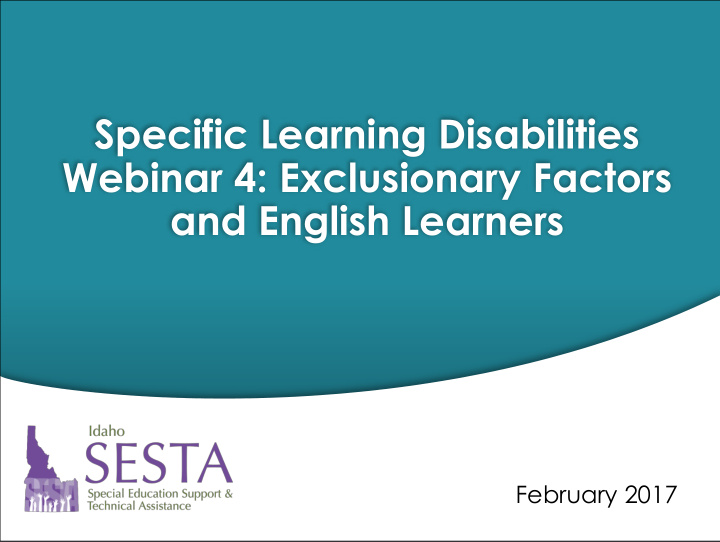



Specific Learning Disabilities Webinar 4: Exclusionary Factors and English Learners February 2017
Objectives Increase your confidence in: l Considering Exclusionary Factors during an evaluation for SLD l Using formal assessment results and comparative data when making an eligibility decision for an English Learner (EL) 2
Other Considerations: Exclusionary Factors 3
Poll 1 Which Exclusionary Factor does your team see most often? § A visual, hearing or motor impairment § An intellectual disability § An emotional disturbance § Environmental or economic disadvantage § Cultural factors § Lack of appropriate instruction in reading or math § Limited English proficiency 4
Section 5: Other Considerations l When evaluating a student’s low achievement, the team must make some considerations. - The student’s learning difficulties are not primarily due to: § A visual, hearing or motor impairment § An intellectual disability § An emotional disturbance § Environmental or economic disadvantage § Cultural factors § Lack of appropriate instruction in reading or math § Limited English proficiency 5
Example -Ellie
Example - Ellie 7
Example - Ellie 8
Support Document
Evaluating English Learners 10
Poll 2 What is your experience in assessing students whose primary language is not English? - None - Some - Most of my caseload is of students who are English Learners 11
Section 6: English Learners l The team must determine that the student’s learning difficulty is not primarily the results of: - Limited English Proficiency 12
English Learner l Formal and informal assessments to determine the student’s primary language § Home Language Survey § WIDA § ACCESS § Woodcock Munoz § IELA § Interviews to determine which language the student speaks most fluently. 13
English Learner l Comparison of acquisition rate: - Document the student’s progress in comparison to similar peers § Same culture, age, similar school history, etc. § May need to look to surrounding districts for this information 14
English Learner Impact of English learning on academic functioning : • Summarize assessment data • Include information from a variety of sources 15
Support Document http://files.eric.ed.gov/full text/ED564264.pdf
Support Document
Remember Not to Over Identify l A student cannot be identified as an individual with a disability if the “determinant factor” is limited English proficiency. 18
Remember Child Find Still Applies l A student suspected of having a disability must not be denied an evaluation, and if eligible, be denied access to special education until he or she becomes proficient in English 19
Remember to Use Appropriate Measures l School districts must consider a student’s English language proficiency in determining appropriate assessments and other evaluation materials to be used when conducting a comprehensive special education evaluation 20
Example - Leo
Remember 22
Questions 23
Next Steps l If you are taking this course for credit: - Complete the quiz with a passing grade (70% or better) prior to the next webinar - Attend Webinar 5 on 3-16-17 at 4:00 MT/ 3:00 PT 24
Cathy Thornton Associate Director Nichole Kristensen Instructional Coordinator Dawn Spurlock Instructional Coordinator www.IdahoSESTA.org
SUPPORTING SCHOOLS AND STUDENTS TO ACHIEVE SHERRI YBARRA, SUPERINTENDENT OF PUBLIC INSTRUCTION
Recommend
More recommend